Libya: Difference between revisions
Dan.krammer (talk | contribs) No edit summary |
|||
| Line 80: | Line 80: | ||
With an area of almost {{convert|1800000|km2|sqmi|-5}}, Libya is the fourth largest country in [[Africa]] by area, and the 17th [[List of countries and outlying territories by total area|largest in the world]].<ref>U.N. Demographic Yearbook, (2003), [http://unstats.un.org/unsd/demographic/products/dyb/DYB2003/Table03.pdf <u>"Demographic Yearbook (3) Pop., Rate of Pop. Increase, Surface Area & Density"<u>], ''United Nations Statistics Division''. Retrieved July 15, 2006.</ref> The [[capital (political)|capital]], [[Tripoli]], is home to 1.7 million of Libya's 6.4 million people. The three traditional parts of the country are [[Tripolitania]], [[Fezzan]], and [[Cyrenaica]]. Libya has the [[List of countries by Human Development Index#Africa|highest HDI in Africa]] and the fourth highest [[Gross domestic product|GDP]] ([[Purchasing power parity|PPP]]) per capita in Africa as of 2009, behind [[Seychelles]], [[Equatorial Guinea]] and [[Gabon]]. These are largely due to its large [[petroleum]] reserves and low population.<ref>Annual Statistical Bulletin, (2004), [http://www.opec.org/library/Annual%20Statistical%20Bulletin/interactive/2004/FileZ/XL/T33.HTM <u>"World proven crude oil reserves by country, 1980–2004"<u>], ''O.P.E.C.''. Retrieved July 20, 2006.</ref><ref>World Economic Outlook Database, (April, 2006), [http://www.imf.org/external/pubs/ft/weo/2006/01/data/dbcoutm.cfm?SD=2005&ED=2005&R1=1&R2=1&CS=3&SS=2&OS=C&DD=0&OUT=1&C=512-941-914-446-612-666-614-672-311-946-213-137-911-962-193-674-122-676-912-548-313-556-419-678-513-181-316-682-913-684-124-273-339-921-638-948-514-686-218-688-963-518-616-728-223-558-516-138-918-353-748-196-618-278-522-692-622-694-156-142-624-449-626-564-628-283-228-853-924-288-233-293-632-566-636-964-634-182-238-453-662-968-960-922-423-714-935-862-128-716-611-456-321-722-243-965-248-718-469-724-253-576-642-936-643-961-939-813-644-199-819-184-172-524-132-361-646-362-648-364-915-732-134-366-652-734-174-144-328-146-258-463-656-528-654-923-336-738-263-578-268-537-532-742-944-866-176-369-534-744-536-186-429-925-178-746-436-926-136-466-343-112-158-111-439-298-916-927-664-846-826-299-542-582-443-474-917-754-544-698&S=NGDPDPC&CMP=0&x=14&y=10 <u>"Report for Selected Countries and Subjects"<u>], ''International Monetary Fund''. Retrieved July 15, 2006.</ref> Libya is one of the top 10 richest oil producing countries. |
With an area of almost {{convert|1800000|km2|sqmi|-5}}, Libya is the fourth largest country in [[Africa]] by area, and the 17th [[List of countries and outlying territories by total area|largest in the world]].<ref>U.N. Demographic Yearbook, (2003), [http://unstats.un.org/unsd/demographic/products/dyb/DYB2003/Table03.pdf <u>"Demographic Yearbook (3) Pop., Rate of Pop. Increase, Surface Area & Density"<u>], ''United Nations Statistics Division''. Retrieved July 15, 2006.</ref> The [[capital (political)|capital]], [[Tripoli]], is home to 1.7 million of Libya's 6.4 million people. The three traditional parts of the country are [[Tripolitania]], [[Fezzan]], and [[Cyrenaica]]. Libya has the [[List of countries by Human Development Index#Africa|highest HDI in Africa]] and the fourth highest [[Gross domestic product|GDP]] ([[Purchasing power parity|PPP]]) per capita in Africa as of 2009, behind [[Seychelles]], [[Equatorial Guinea]] and [[Gabon]]. These are largely due to its large [[petroleum]] reserves and low population.<ref>Annual Statistical Bulletin, (2004), [http://www.opec.org/library/Annual%20Statistical%20Bulletin/interactive/2004/FileZ/XL/T33.HTM <u>"World proven crude oil reserves by country, 1980–2004"<u>], ''O.P.E.C.''. Retrieved July 20, 2006.</ref><ref>World Economic Outlook Database, (April, 2006), [http://www.imf.org/external/pubs/ft/weo/2006/01/data/dbcoutm.cfm?SD=2005&ED=2005&R1=1&R2=1&CS=3&SS=2&OS=C&DD=0&OUT=1&C=512-941-914-446-612-666-614-672-311-946-213-137-911-962-193-674-122-676-912-548-313-556-419-678-513-181-316-682-913-684-124-273-339-921-638-948-514-686-218-688-963-518-616-728-223-558-516-138-918-353-748-196-618-278-522-692-622-694-156-142-624-449-626-564-628-283-228-853-924-288-233-293-632-566-636-964-634-182-238-453-662-968-960-922-423-714-935-862-128-716-611-456-321-722-243-965-248-718-469-724-253-576-642-936-643-961-939-813-644-199-819-184-172-524-132-361-646-362-648-364-915-732-134-366-652-734-174-144-328-146-258-463-656-528-654-923-336-738-263-578-268-537-532-742-944-866-176-369-534-744-536-186-429-925-178-746-436-926-136-466-343-112-158-111-439-298-916-927-664-846-826-299-542-582-443-474-917-754-544-698&S=NGDPDPC&CMP=0&x=14&y=10 <u>"Report for Selected Countries and Subjects"<u>], ''International Monetary Fund''. Retrieved July 15, 2006.</ref> Libya is one of the top 10 richest oil producing countries. |
||
Independent since 1951, Libya has been ruled from 1969 to the present by [[Muammar al-Gaddafi]], who rose to power in a military coup. Al-Gaddafi is currently facing the greatest challenge to his rule, with a [[2011 Libyan protests|popular uprising]] taking place that began in the country in mid-February 2011, following the [[Tunisia Effect]]. |
|||
Independent since 1951, Libya has been ruled from 1969 to the present by [[Muammar al-Gaddafi]], who rose to power in a military coup. Still ongoing [[2011 Libyan protests|anti-government mass protests]] began in the country in mid-February 2011. On 21 February, [[United Kingdom|British]] [[Secretary of State for Foreign and Commonwealth Affairs|Foreign Secretary]] [[William Hague]] stated that he had received information that Muammar al-Gaddafi had left Libya and was travelling to [[Venezuela]]. The Venezuelan government denied this.<ref name="bbc update">{{Cite web | last = Bell | first = Sarah | last2 = Blenford | first2 = Adam | last3 = Fouché | first3 = Alexandra | last4 = Hirst | first4 = Michael | title = Live: Middle East and North Africa Unrest | work = News Middle East | publisher = British Broadcasting Corporation | date = 18 February 2011 | url = http://www.bbc.co.uk/news/world-middle-east-12307698 | accessdate = 21 February 2011}}</ref><ref name="international business times">{{Cite web | title = Libyan Unrest Spreads to Tripoli Amidst Rumors Gaddafi Has Fled to Venezuela | publisher = International Business Times | date = 21 February 2011 | url = http://uk.ibtimes.com/articles/114364/20110221/libya.htm | accessdate = 21 February 2011}}</ref> |
|||
==Name== |
==Name== |
||
Revision as of 23:55, 21 February 2011
This article documents a current event. Information may change rapidly as the event progresses, and initial news reports may be unreliable. The latest updates to this article may not reflect the most current information. (February 2011) |
Great Socialist People's Libyan Arab Jamahiriya الجماهيرية العربية الليبية الشعبية الإشتراكية العظمى Al Jamāhīriyyah al 'Arabiyyah al Lībiyyah aš Ša'biyyah al Ištirākiyyah al 'Uẓmā Template:Ar icon | |
|---|---|
| Anthem: Allahu Akbar God is the Greatest | |
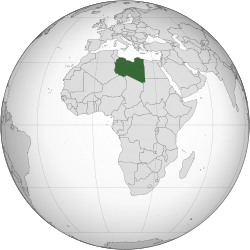 | |
| Capital and largest city | Tripoli |
| Official languages | Arabic1 |
| Demonym(s) | Libyan |
| Government | Jamahiriya |
| Muammar al-Gaddafi | |
| Mohamed Abdul Quasim al-Zwai | |
| Baghdadi Mahmudi | |
| Independence | |
• Relinquished by Italy | 10 February 1947 |
24 December 1951 | |
| 1 September 1969 | |
| Area | |
• Total | 1,759,541 km2 (679,363 sq mi) (17th) |
• Water (%) | Negligible surface water, reservoirs of water underground. |
| Population | |
• 2010 estimate | 6,420,000[1] (105th) |
• 2006 census | 5,670,6881 |
• Density | 3.6/km2 (9.3/sq mi) (218th) |
| GDP (PPP) | 2010 estimate |
• Total | $96.138 billion[2] (68th) |
• Per capita | $14,884[2] (56th) |
| GDP (nominal) | 2010 estimate |
• Total | $76.557 billion[2] (64th) |
• Per capita | $11,852[2] (48th) |
| HDI (2010) | Error: Invalid HDI value (53rd) |
| Currency | Dinar (LYD) |
| Time zone | UTC+2 (EET) |
| Drives on | Right |
| Calling code | 218 |
| ISO 3166 code | LY |
| Internet TLD | .ly |
| |
| History of Libya | ||||||||||||||||||||||||||||||||||||||
|---|---|---|---|---|---|---|---|---|---|---|---|---|---|---|---|---|---|---|---|---|---|---|---|---|---|---|---|---|---|---|---|---|---|---|---|---|---|---|
 | ||||||||||||||||||||||||||||||||||||||
|
||||||||||||||||||||||||||||||||||||||
|
| ||||||||||||||||||||||||||||||||||||||
Libya (Template:Lang-ar Lībiyā) is a country located in the Maghreb region of northern Africa. Bordering the Mediterranean Sea to the north, Libya lies between Egypt to the east, Sudan to the south east, Chad and Niger to the south, and Algeria and Tunisia to the west.
With an area of almost 1,800,000 square kilometres (700,000 sq mi), Libya is the fourth largest country in Africa by area, and the 17th largest in the world.[4] The capital, Tripoli, is home to 1.7 million of Libya's 6.4 million people. The three traditional parts of the country are Tripolitania, Fezzan, and Cyrenaica. Libya has the highest HDI in Africa and the fourth highest GDP (PPP) per capita in Africa as of 2009, behind Seychelles, Equatorial Guinea and Gabon. These are largely due to its large petroleum reserves and low population.[5][6] Libya is one of the top 10 richest oil producing countries.
Independent since 1951, Libya has been ruled from 1969 to the present by Muammar al-Gaddafi, who rose to power in a military coup. Al-Gaddafi is currently facing the greatest challenge to his rule, with a popular uprising taking place that began in the country in mid-February 2011, following the Tunisia Effect.
Name
The name Libya (/[invalid input: 'En-us-Libya.ogg']ˈlɪbiə/; Template:Lang-ar Lībyā ⓘ; Libyan vernacular: Lībya ⓘ) originally derives from the Libu Berber tribesmen (Egyptian r'bw, Punic lby 𐤉𐤁𐤋). The name was adopted in Greek as Λίβυες (Líbues), Latinized to Libyes (with Greek υ transcribed as y in Latin). The land of the Libu was Λιβύη (Libúē) and Λιβύᾱ (Libúā) in the Attic and Doric dialects respectively, entering Latin as Libya. In Classical Greece the term had a broader meaning, encompassing all the continent that later (2nd century BC) came to be known as Africa, in antiquity assumed to make up one third of the world's landmass, besides Europe and Asia.
During the Islamic Middle Ages (Ibn Khaldun), the Libu were known as the Lawata.[7]
The full official title of the state is the Great Socialist People's Libyan Arab Jamahiriya ( Template:Lang-ar Al-Jamāhīriyyah al-ʿArabiyyah al-Lībiyyah aš-Šaʿbiyyah al-Ištirākiyyah al-ʿUẓmā ⓘ).
Jamahiriya (Arabic جماهيرية, strict transliteration jamāhīriyya) is an Arabic term generally translated as "state of the masses". The term, a neologism coined by Muammar al-Gaddafi, is intended to be a generic term describing a type of state: a "republic ruled by the masses" or "people's republic".
History
Prehistoric Libya

Tens of thousands of years ago, the Sahara desert, which now covers roughly 90% of Libya, was lush with green vegetation. It was home to lakes, forests, diverse wildlife and a temperate Mediterranean climate. Archaeological evidence indicates that the coastal plain of Ancient Libya was inhabited by the Neolithic Berbers from as early as 8000 BCE. These peoples were perhaps drawn by the climate, which enabled their culture to grow; the Berbers were skilled in the domestication of cattle and the cultivation of crops.[8]
Rock paintings and carvings at Wadi Mathendous and the mountainous region of Jebel Acacus are the best sources of information about prehistoric Libya, and the pastoralist culture that settled there. The paintings reveal that the Libyan Sahara contained rivers, grassy plateaus and an abundance of wildlife such as giraffes, elephants and crocodiles.
Pockets of Berber population remain in modern Libya, but dispersal of Berbers north as far as Ireland and Scandinavia is documented in genetic markers.[citation needed] Dispersal in Africa from the Atlantic coast to the Siwa oasis in Egypt seems to have followed, due to climatic changes which caused increasing desertification. It is thought that the indigenous Libyan civilization of the Garamantes, based in Germa, originated from this time, or may have done so even earlier when the Sahara was still green. The Garamantes were a Saharan people of Berber origin who used an elaborate underground irrigation system, and founded a kingdom in the Fezzan area of modern-day Libya. They were probably present as tribal people in the Fezzan by 1000 BCE, and were a local power in the Sahara between 500 BCE and 500 ACE. By the time of contact with the Phoenicians, the first of the outside civilisations to arrive in Libya from the East, the Garamantes and other local Berber tribes that lived in the Sahara were already well established.
Phoenician Tripolitania and the Greek Pentapolis
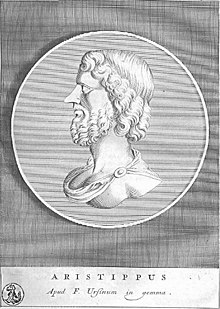
The Phoenicians were the first to establish trading posts in Libya, when the merchants of Tyre (in present-day Lebanon) developed commercial relations with the Berber tribes and made treaties with them to ensure their cooperation in the exploitation of raw materials.[9][10] By the 5th century BCE, the greatest of the Phoenician colonies, Carthage, had extended its hegemony across much of North Africa, where a distinctive civilization, known as Punic, came into being. Punic settlements on the Libyan coast included Oea (later Tripoli), Libdah (later Leptis Magna) and Sabratha. These cities were in an area that was later called Tripolis, or "Three Cities", from which Libya's modern capital Tripoli takes its name.
In 630 BC, the Ancient Greeks conquered Eastern Libya and founded the city of Cyrene.[11] Within 200 years, four more important Greek cities were established in the area that became known as Cyrenaica: Barce (later Al Marj); Euhesperides (later Berenice, present-day Benghazi); Teuchira (later Arsinoe, present-day Tukrah); and Apollonia (later Susah), the port of Cyrene. Together with Cyrene, they were known as the Pentapolis (Five Cities). Cyrene became one of the greatest intellectual and artistic centers of the Greek world, and was famous for its medical school, learned academies, and architecture. The Greeks of the Pentapolis resisted encroachments by the Egyptians from the East, as well as by the Carthaginians from the West, but in 525 BCE the Persian army of Cambyses II overran Cyrenaica, which for the next two centuries remained under Persian or Egyptian rule. Alexander the Great was greeted by the Greeks when he entered Cyrenaica in 331 BCE, and Eastern Libya once again fell under the control of the Greeks, this time as part of the Ptolemaic Kingdom. Later, a federation of the Pentapolis was formed that was customarily ruled by a king drawn from the Ptolemaic royal house.
Roman Libya
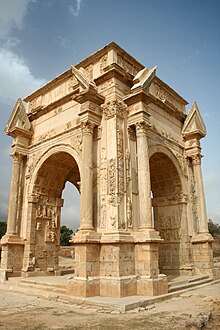
The Romans invaded Tripolitania (the region around Tripoli) in 106 BCE. Ptolemy Apion, the last Greek ruler, bequeathed Cyrenaica to Rome, which formally annexed the region in 74 BC and joined it to Crete as a Roman province. By 64 BC, Julius Caesar's legions had established their occupation, and the Romans had thus unified all three regions of Libya. As a Roman province, Libya was prosperous, and reached a golden age in the 2nd and 3rd centuries, when the city of Leptis Magna was at its height. For more than 400 years, Tripolitania and Cyrenaica were wealthy Roman provinces and part of a cosmopolitan state whose citizens shared a common language, legal system, and Roman identity. Roman ruins like those of Leptis Magna, extant in present-day Libya, attest to the vitality of the region, where populous cities and even smaller towns enjoyed the amenities of urban life - the forum, markets, public entertainments, and baths - found in every corner of the Roman Empire. Merchants and artisans from many parts of the Roman world established themselves in North Africa, but the character of the cities of Tripolitania remained decidedly Punic and, in Cyrenaica, Greek. Tripolitania was a major exporter of olive oil, as well as a centre for the gold and slaves conveyed to the coast by the Garamentes, while Cyrenaica remained an important source of wines, drugs, and horses. The bulk of the population in the countryside consisted of Berber farmers, who in the west were thoroughly "romanized" in language and customs.[12] Until the X century the African Romance remained in use in some Tripolitanian areas , mainly near the Tunisian border.[13] .

The decline of the Roman Empire saw the classical cities fall into ruin, a process hastened by the Vandals' destructive sweep though North Africa in the 5th century ACE. The region's prosperity had shrunk under Vandal domination, and the old Roman political and social order, disrupted by the Vandals, could not be restored. In outlying areas neglected by the Vandals, the inhabitants had sought the protection of tribal chieftains and, having grown accustomed to their autonomy, resisted reassimilation into the imperial system. When the Byzantines took over in the 6th century ACE, efforts were made to strengthen the old cities, but it was only a last gasp before they collapsed into disuse. Cyrenaica, which had remained an outpost of the Byzantine Empire during the Vandal period, also took on the characteristics of an armed camp. Unpopular Byzantine governors imposed burdensome taxation to meet military costs, while the towns and public services—including the water system—were left to decay. Byzantine rule in Africa did prolong the Roman ideal of imperial unity there for another century and a half however, and prevented the ascendancy of the Berber nomads in the coastal region. By the beginning of the 7th century ACE, Byzantine control over the region was weak, Berber rebellions were becoming more frequent, and there was little to oppose Muslim invasion.
Arab Islamic Rule 642–1551
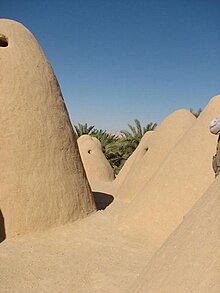
Tenuous Byzantine control over Libya was restricted to a few poorly defended coastal strongholds, and as such, the Arab horsemen who first crossed into the Pentapolis of Cyrenaica in September 642 AC encountered little resistance. Under the command of Amr ibn al-A'as, the armies of Islam conquered Cyrenaica, and renamed the Pentapolis, Barqa. By 647 AC, an army of 40,000 Arabs, led by ‘Abdu’llah ibn Sa‘ad, the foster-brother of Caliph Uthman, penetrated deep into Western Libya and took Tripoli from the Byzantines in 643 AC. From Barqa, the Fezzan (Libya's Southern region) was conquered by Uqba ibn Nafi in 663 AC and Berber resistance was overcome. During the following centuries Libya came under the rule of several Islamic dynasties, under various levels of autonomy from Ummayad, Abbasid and Fatimid caliphates of the time. Arab rule was easily imposed in the coastal farming areas and on the towns, which prospered again under Arab patronage. Townsmen valued the security that permitted them to practice their commerce and trade in peace, while the punicized farmers recognized their affinity with the Semitic Arabs to whom they looked to protect their lands. In Cyrenaica, Monophysite adherents of the Coptic Church had welcomed the Muslim Arabs as liberators from Byzantine oppression. The Berber tribes of the hinterland accepted Islam, however they resisted Arab political rule.
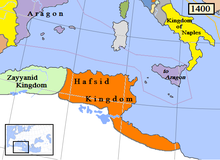
For the next several decades, Libya was under the purview of the Ummayad Caliph of Damascus until the Abbasids overthrew the Ummayads in 750 CE, and Libya came under the rule of Baghdad. When Caliph Harun al-Rashid appointed Ibrahim ibn al-Aghlab as his governor of Ifriqiya in 800 AC, Libya enjoyed considerable local autonomy under the Aghlabid dynasty. The Aghlabids were amongst the most attentive Islamic rulers of Libya; they brought about a measure of order to the region, and restored Roman irrigation systems, which brought prosperity to the area from the agricultural surplus. By the end of the 9th century CE, the Shiite Fatimids controlled Western Libya from their capital in Mahdia, before they ruled the entire region from their new capital of Cairo in 972 CE and appointed Buluggin ibn Ziri as governor. During Fatimid rule, Tripoli thrived on the trade in slaves and gold brought from the Sudan and on the sale of wool, leather, and salt shipped from its docks to Italy in exchange for wood and iron goods. Ibn Ziri's Berber Zirid Dynasty ultimately broke away from the Shiite Fatimids, and recognised the Sunni Abbasids of Baghdad as rightful Caliphs. In retaliation, the Fatimids brought about the migration of as many as 200,000 families from two Bedouin tribes, the Banu Sulaym and Banu Hilal to North Africa - this act completely altered the fabric of Libyan cities, and cemented the cultural and linguistic Arabisation of the region.

After the subsequent social unrest during Zirid rule, the coast of Libya was weakened and invaded by the Normans of Sicily. It was not until 1174 that the Ayyubid Sharaf al-Din Qaraqush reconquered Tripoli from European rule with an army of Turks and Bedouins. Afterwards, a viceroy from the Almohads, Muhammad ibn Abu Hafs, ruled Libya from 1207 to 1221 before the later establishment of a Hafsid dynasty independent from the Almohads. The Hafsids ruled Tripolitania for nearly 300 years, and established significant trade with the city-states of Europe. Hafsid rulers also encouraged art, literature, architecture and scholarship. Ahmad Zarruq was one of the most famous Islamic scholars to settle in Libya, and did so during this time. By the 16th century however, the Hafsids became increasingly caught up in the power struggle between Spain and the Ottoman Empire. After a successful invasion of Tripoli by Habsburg Spain in 1510, and its handover to the Knights of St. John, the Ottomans finally took control of Libya in 1551.
Ottoman Regency 1551–1911
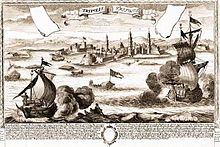
After a successful invasion by the Habsburgs of Spain in the early 16th century, Charles V entrusted its defense to the Knights of St. John in Malta. Lured by the piracy that spread through the Maghrib coastline, adventurers such as Barbarossa and his successors consolidated Ottoman control in the central Maghrib. The Ottoman Turks conquered Tripoli in 1551 under the command of Turgut (Darghouth) Reis. In the next year Turgut was named the Bey of Tripoli and later Pasha of Tripoli in 1556. As Pasha, he adorned and built up Tripoli making it one of the most impressive cities along the North African coast.[14] By 1565, administrative authority as regent in Tripoli was vested in a pasha appointed directly by the sultan in Constantinople. In the 1580s, the rulers of Fezzan gave their allegiance to the sultan, and although Ottoman authority was absent in Cyrenaica, a bey was stationed in Benghazi late in the next century to act as agent of the government in Tripoli.
In time, real power came to rest with the pasha’s corp of janissaries, a self-governing military guild, and in time the pasha’s role was reduced to that of ceremonial head of state. Mutinies and coups were frequent, and in 1611 the deys staged a coup against the pasha, and Dey Sulayman Safar was appointed as head of government. For the next hundred years, a series of deys effectively ruled Tripolitania some for only a few weeks, and at various times the dey was also pasha-regent. The regency governed by the dey was autonomous in internal affairs and, although dependent on the sultan for fresh recruits to the corps of janissaries, his government was left to pursue a virtually independent foreign policy as well.

Tripoli was the only city of size in Ottoman Libya (then known as Tripolitania Eyalet) at the end of the 17th century and had a population of about 30,000. The bulk of its residents were Moors, as city dwelling Arabs were then known. Several hundred Turks and renegades formed a governing elite, a large portion of which were kouloughlis (lit. sons of servants - offspring of Turkish soldiers and Arab women); they identified with local interests and were respected by locals. Jews and Moriscos were active as merchants and craftsmen and a small number of European traders also frequented the city. European slaves and large numbers of enslaved blacks transported from the Sudan were also a feature of everyday life in Tripoli.
Lacking direction from the Ottoman government, Tripoli lapsed into a period of military anarchy during which coup followed coup and few deys survived in office more than a year. One such coup was by Ahmed Pasha Karamanli. The Karamanlis ruled from 1711 until 1835 mainly in Tripolitania, but had influence in Cyrenaica and Fezzan as well by the mid 18th century. Ahmed was a janissary and popular cavalry officer. He murdered the Ottoman governor of Tripolitania and seized the throne in 1711. After persuading the Ottomans to recognize him as governor, Ahmed established himself as pasha and made his post hereditary. Though Tripolitania continued to pay nominal tribute to the Ottoman padishah, it otherwise acted as an independent kingdom. Ahmed greatly expanded his city's economy, particularly through the employment of corsairs on crucial Mediterranean shipping routes; nations that wished to protect their ships from the corsairs were forced to pay tribute to the pasha. Ahmad's successors proved to be less capable than himself, however, the region's delicate balance of power allowed the Karamanli to survive several dynastic crises without invasion. In 1793, Turkish officer Ali Benghul deposed Hamet Karamanli and briefly restored Tripolitania to Ottoman rule. However, Hamet's brother Yusuf (r. 1795–1832) reestablished Tripolitania's independence.
In the early 19th century war broke out between the United States and Tripolitania, and a series of battles ensued in what became to be known as the Barbary Wars. By 1819, the various treaties of the Napoleonic Wars had forced the Barbary states to give up piracy almost entirely, and Tripolitania's economy began to crumble. As Yusuf weakened, factions sprung up around his three sons; though Yusuf abdicated in 1832 in favor of his son Ali II, civil war soon resulted. Ottoman Sultan Mahmud II sent in troops ostensibly to restore order, but instead deposed and exiled Ali II, marking the end of both the Karamanli dynasty and an independent Tripolitania.
The second period of direct Ottoman rule saw administrative changes, and what seemed as greater order in the governance of the three provinces of Libya. In general however, 19th century Ottoman rule was characterised by corruption, revolt and repression. The region of Libya in particular became a backwater province in a decaying empire that had been dubbed the "sick man of Europe". It would not be long before the Scramble for Africa and European colonial interests set their eyes on the marginal Turkish provinces of Libya.
Italian Colony and WWII 1911–1951

From 1912 to 1927, the territory of Libya was known as Italian North Africa. From 1927 to 1934, the territory was split into two colonies, Italian Cyrenaica and Italian Tripolitania, run by Italian governors. During the Italian colonial period, between 20% and 50% of the Libyan population died in the struggle for independence, and mainly in prison camps.[citation needed] Some 150,000 Italians settled in Libya, constituting roughly 20% of the total population.[15]
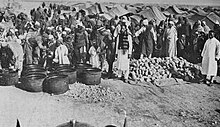
In 1934, Italy adopted the name "Libya" (used by the Greeks for all of North Africa, except Egypt) as the official name of the colony (made up of the three provinces of Cyrenaica, Tripolitania and Fezzan). King Idris I, Emir of Cyrenaica, led Libyan resistance to Italian occupation between the two world wars. Between 1928 and 1932 the Italian military "killed half the Bedouin population (directly or through starvation in camps)."[16]
From 1943 to 1951, Tripolitania and Cyrenaica were under British administration, while the French controlled Fezzan. In 1944, Idris returned from exile in Cairo but declined to resume permanent residence in Cyrenaica until the removal of some aspects of foreign control in 1947. Under the terms of the 1947 peace treaty with the Allies, Italy relinquished all claims to Libya.[17]
Independence and the United Kingdom of Libya 1951–1969
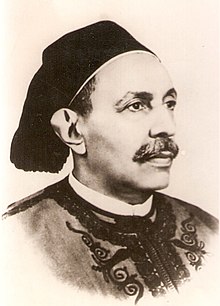
On November 21, 1949, the UN General Assembly passed a resolution stating that Libya should become independent before January 1, 1952. Idris represented Libya in the subsequent UN negotiations. On December 24, 1951, Libya declared its independence as the United Kingdom of Libya, a constitutional and hereditary monarchy under King Idris, Libya's first and only monarch.
1951 also saw the enactment of the Libyan Constitution. The enactment of the Libyan Constitution was significant in that it was the first piece of legislation to formally entrench the rights of Libyan citizens Libyan Constitution following the post-war creation of the Libyan nation state. Following on from the intense UN debates during which Idris had argued that the creation of a single Libyan state would be of benefit to the regions of Tripolitania, Fezzan, and Cyrenaica, the Libyan government was keen to formulate a constitution which contained many of the entrenched rights common to European and North American nation states. Thus, not creating a secular state (Article 5 proclaims Islam the religion of the State), the Libyan Constitution did formally set out rights such as equality before the law as well as equal civil and political rights, equal opportunities, and an equal responsibility for public duties and obligations, "without distinction of religion, belief, race, language, wealth, kinship or political or social opinions" (Article 11). Following the coup led by the Libyan army on 1 September 1969 and Idris' subsequent abdication, the Libyan Constitution ceased to have any significance.
The discovery of significant oil reserves in 1959 and the subsequent income from petroleum sales enabled one of the world's poorest nations to establish an extremely wealthy state. Although oil drastically improved the Libyan government's finances, resentment among some factions began to build over the increased concentration of the nation's wealth in the hands of King Idris. This discontent mounted with the rise of Nasserism and Arab nationalism throughout North Africa and the Middle East, so while the continued presence of Americans, Italians and British in Libya aided in the increased levels of wealth and tourism following WWII, it was seen by some as a threat.
During this period, Britain was involved in extensive engineering projects in Libya and was also the country's biggest supplier of arms. The United States also maintained the large Wheelus Air Base in Libya.
1969 revolution
On 1 September 1969, a small group of military officers led by then 27-year-old army officer Muammar al-Gaddafi staged a coup d'état against King Idris, launching the Libyan Revolution.[18] At the time, Idris was in Turkey for medical treatment. His nephew, Crown Prince Sayyid Hasan ar-Rida al-Mahdi as-Sanussi was exercising regal powers at the time of the revolution as King Idris had sent a signed document indicating his intent to step down as King on 2 September 1969. It was clear however that the revolutionary officers who had announced the deposition of King Idris did not want to appoint Crown Prince Hassan over the instruments of state as King, and so the Crown Prince was never effectively King.
Gaddafi was at the time only a captain and his co-conspirators were all junior officers. Nevertheless the small group seized Libyan military headquarters (due to the sympathies of the stationed men) and the radio broadcasting station with 48 rounds of revolver ammunition.[19] Before the end of 1 September, Sayyid Hasan ar-Rida had been formally deposed by the revolutionary army officers and put under house arrest. Meanwhile, revolutionary officers abolished the monarchy, and proclaimed the new Libyan Arab Republic. Gaddafi was, and is to this day, referred to as the "Brother Leader and Guide of the Revolution" in government statements and the official press.[20]
2011 civil unrest
After popular movements overturned the rulers of its immediate neighbors to the west and east (Tunisia and Egypt, respectively), Libya experienced a full-scale revolt (the 2011 Libyan protests) beginning in February 2011. [21][22] By 20 February, the unrest had spread to Tripoli. In the early hours of 21 February 2011 (Tripoli time), Seif al-Islam, oldest son of Muammar Gaddafi, spoke on Libyan television of his fears that the country would fragment and be replaced by "15 Islamic fundamentalist emirates" if the uprising engulfed the entire state. He warned that the country's economic wealth and recent prosperity was at risk, admitted that "mistakes had been made" in quelling recent protests and announced that a constitutional convention would begin on 23 February. This convention would have the aim of reforming and democratising the constitution.[citation needed] Shortly after this speech, the Libyan Ambassador to India announced on BBC Radio 5 live that he had resigned in protest at the "massacre" of protesters. Rumours began to circulate as to the whereabouts of Colonel Gaddafi, with unsubstantiated sources claiming that he had fled the country, possibly to Venezuela.[23][24] Two Libyan Air Force colonels flew their F-1 Mirage jets to Malta and defected after refusing orders to bomb protesters.[25][26]
It is only a matter of time before Qaddafi is overthrown. He has spilled the blood of his countrymen for too long. Soon they will bring him to justice and he shall be made to kneel before the Libyan people and bear their wrath.
Politics

There are two branches of government in Libya. The "revolutionary sector" comprises Revolutionary Leader Gaddafi, the Revolutionary Committees and the remaining members of the 12-person Revolutionary Command Council, which was established in 1969.[27] The historical revolutionary leadership is not elected and cannot be voted out of office; they are in power by virtue of their involvement in the revolution.
The second sector, the Jamahiriya sector, comprises Local People's Congresses in each of the 1,500 urban wards, 32 Sha'biyat People's Congresses for the regions, and the National General People's Congress. These legislative bodies are represented by corresponding executive bodies (Local People's Committees, Sha'biyat People's Committees and the National General People's Committee/Cabinet).
Every four years, the membership of the Local People's Congresses elects their own leaders and the secretaries for the People's Committees, sometimes after many debates and a critical vote. The leadership of the Local People's Congress represents the local congress at the People's Congress of the next level. The members of the National General People's Congress elect the members of the National General People's Committee (the Cabinet) at their annual meeting.
The government controls both state-run and semi-autonomous media. In cases involving a violation of "certain taboos", the private press, like The Tripoli Post, has been censored,[28] although articles that are critical of policies have been requested and intentionally published by the revolutionary leadership itself as a means of initiating reforms.
Political parties were banned by the 1972 Prohibition of Party Politics Act Number 71.[29] According to the Association Act of 1971, the establishment of non-governmental organisations (NGOs) is allowed. However, because they are required to conform to the goals of the revolution, their numbers are small in comparison with those in neighbouring countries. Trade unions do not exist,[30] but numerous professional associations are integrated into the state structure as a third pillar, along with the People's Congresses and Committees. These associations do not have the right to strike. Professional associations send delegates to the General People's Congress, where they have a representative mandate.
Foreign relations
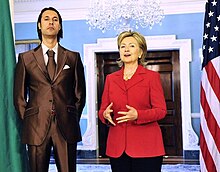
Libya's foreign policies have undergone much fluctuation and change since the state was proclaimed on December 24, 1951. As a Kingdom, Libya maintained a definitively pro-Western stance, yet was recognized as belonging to the conservative traditionalist bloc in the League of Arab States (the present-day Arab League), of which it became a member in 1953.[31] The government was in close alliance with Britain and the United States; both countries maintained military base rights in Libya. Libya also forged close ties with France, Italy, Greece, and established full diplomatic relations with the Soviet Union in 1955.
Although the government supported Arab causes, including the Moroccan and Algerian independence movements, it took little active part in the Arab-Israeli dispute or the tumultuous inter-Arab politics of the 1950s and early 1960s. The Kingdom was noted for its close association with the West, while it steered an essentially conservative course at home.[32]
After the 1969 coup, Gaddafi closed American and British bases and partially nationalized foreign oil and commercial interests in Libya. He also played a key role in promoting oil embargoes as a political weapon for challenging the West, hoping that an oil price rise and embargo in 1973 would persuade the West, especially the United States, to end support for Israel. Gaddafi rejected both Eastern (Soviet) communism and Western (United States) capitalism and claimed he was charting a middle course for his government.[33]
In the 1980s, Libya increasingly distanced itself from the United States, based on the principle of non-alignment and the adoption of a middle path between capitalism and communism referred to as "the Third Theory".[34] The animosity was deepened due to Gaddafi’s support for groups like the Palestine Liberation Organization, which were considered terrorist organizations by the United States Government, and his flirtation with the Soviet Union, which at the time represented the sole challenger to the US. Secretary of State Alexander Haig considered Libya as “a Soviet satellite” and a “Soviet-run terrorist training network". When Libya intervened in Chad in 1980 it was perceived by the American authorities as the Soviet Union’s attempt to spread control in Africa. In addition to this, Gaddafi’s opposition to Israel, a United States ally and considered by them to be the only democratic state in the region, were enough reasons to have Libya considered an American enemy. Consequently, the Reagan administration began its campaign of assisting Libya’s neighbors militarily to be able to respond to any Libyan attempt to invade them. Tunisia was given some fifty-four M60 tanks plus $15 million in military credits, while other countries like Egypt and Sudan were given an increase in military credits and training with a full-fledged promise of support in face of Libyan threats. These strategies aimed at isolating Libya and pressure it to reconsider its policies towards the US.[35]
The first confrontation with the United States was when Gaddafi had declared two hundred miles of the Gulf of Sidra to be restricted of any international usage; having defied such declaration Libyan air force fired a missile at a US Boeing EC-135 flight. The attack did not cause any damages to the aircraft, and Jimmy Carter, the U.S. President at the time, did not respond militarily. Allegedly, Gaddafi had secretly ordered the burning down of the US embassy in Tripoli as his fight against the United States. In response U.S. President Ronald Reagan had the "Libyan People's Bureau" closed, and oil imports banned from North African States. Reagan also contested the restricted area defined by Gaddafi based on a 1958 convention that stated that countries were allowed to claim twenty four miles of width from their coasts.[36] On August 19, 1981[37] the navy was sent close to Libya's coast which resulted in a confrontation where two of the SU-22 fighters supplied to Libya by the Soviet Union were shot down.[38] Following this, Libya was implicated in committing mass acts of state-sponsored terrorism. When CIA allegedly intercepted two messages implying Libyan complicity in the Berlin discothèque terrorist bombing that killed two American servicemen, the United States mounted a counterstrike launch - the aerial bombing attack - against targets near Tripoli and Benghazi in April 1986.[39] The attack, Operation El Dorado Canyon, was not sanctioned by France and Spain, who refused to allow US F-111 bombers to fly over their territories, and resulted in the death of several civilians, including Gaddafi's two-year old adopted daughter.[40]
In 1991, two Libyan intelligence agents were indicted by federal prosecutors in the United States and the United Kingdom for their involvement in the December 1988 bombing of Pan Am Flight 103. Six other Libyans were put on trial in absentia for the 1989 bombing of UTA Flight 772 over Chad and Niger. The UN Security Council demanded that Libya surrender the suspects, cooperate with the Pan Am 103 and UTA 772 investigations, pay compensation to the victims' families, and cease all support for terrorism. Libya's refusal to comply led to the approval of Security Council Resolution 748 on March 31, 1992, imposing sanctions on the state designed to bring about Libyan compliance. Continued Libyan defiance led to further sanctions by the UN against Libya in November 1993.[41]
In 1999, less than a decade after the sanctions were put in place, Libya began to make dramatic policy changes in regard to the Western world, including turning over the Lockerbie suspects for trial. This diplomatic breakthrough followed years of negotiation, including a visit by UN Secretary General Kofi Annan to Libya in December 1998, and personal appeals by Nelson Mandela. Eventually UK Foreign Secretary Robin Cook persuaded the Americans to accept a trial of the suspects in the Netherlands under Scottish law, with the UN Security Council agreeing to suspend sanctions as soon as the suspects arrived in the Netherlands for trial.[18]
In response to 9/11 attacks Gaddafi condemned the attacks as an act of terrorism and urged Libyans to donate blood for the US victims. However, the United States were still not willing to remove the sanctions of Libya yet. After the invasion of Iraq based on allegations that it had WMD programs violating non-proliferation treaty, and the fall of Saddam Hussein in 2003, the Libyan government announced its decision to abandon its weapons of mass destruction programmes and pay almost 3 billion US dollars in compensation to the families of Pan Am Flight 103 as well as UTA Flight 772.[42] According to some sources[citation needed] Gaddafi had privately phoned Italian Premier Silvio Berlusconi expressing his fear that his regime would meet the same fate if he did not take such steps.[43] The decision was welcomed by many western nations and was seen as an important step for Libya toward rejoining the international community.[44] Since 2003 the country has made efforts to normalize its ties with the European Union and the United States and has even coined the catchphrase, 'The Libya Model', an example intended to show the world what can be achieved through negotiation rather than force when there is goodwill on both sides. By 2004 Bush had lifted the economic sanctions on Libya and official relations resumed between Libya and the United States. Libya then opened a Liaison office in Washington, DC and the United States opened an office in Tripoli. In January 2004, Congressman Tom Lantos led the first official Congressional delegation visit to Libya.[45]
An event considered pivotal by many in Libyan-Western relations is the HIV trials (1999–2007) of five Bulgarian nurses and a Palestinian doctor. Their release is seen as marking a new stage in Libyan-Western relations.
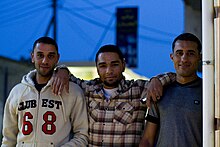
On May 15, 2006 the United States State Department announced it would fully restore diplomatic relations with Libya if it dismantled its weapons programmes. The State Department also removed Libya from their state sponsored terrorism list which it had been on for 27 years. This move has also been attributed[by whom?] to the pressures of oil companies lobbying the Congress[citation needed]. In addition to that the fall of the Soviet power, the prominent role that Libya plays in the African Continent, and the assistance it could provide to the US in its war on terror are among the other considerations that were factored in.[46] In August 2008 a motion was introduced in the 110th Congress known as S 3370 or the “Libyan Claims Resolution Act” to exempt Libya from the infamous section 1083 clause of the National Defense Authorization Act. The motion passed both the House of Representatives and the Senate by unanimous consent, and is signed into law by President George W. Bush on 4 August. After Libya paid a final portion of $1.8 billion global settlement fund for American victims it became formally exempted from section 1083. Following that Libyan families received $300 million for casualties suffered due to the 1986 airstrikes led by the United States. In November the same year, the United States Senate confirmed Gene A. Cretz as the first US Ambassador to Libya in over 35 years. The final step in the process of rebuilding the relations between the two countries came in January 2009 when Ali Suleiman Aujali presented his letters of credentials to President George W. Bush as Ambassador Extraordinaire and Plenipotentiary of Libya to the United States of America, and Gene A. Cretz presents his letter of credentials before the General People’s Congress; currently both are serving as Ambassadors to their respective countries.[47]
On October 16, 2007, Libya was voted to serve on the United Nations Security Council for two years starting January 2008.[48]
In February 2009, Gaddafi was selected to be chairman of the African Union for one year.
In 2009 Britain and Libya signed a prisoner-exchange agreement and then Libya requested the transfer of the convicted Lockerbie bomber, who finally returned home in August 2009.[49]
As of October 25, 2009, Canadian visa requests are being denied and Canadian travellers have been told they are not welcome in Libya, in an apparent reprisal for Canada's near tongue-lashing[vague] of Moammar Gadhafi.[50] Libyan-Swiss relations strongly suffered after the arrest of Hannibal Gadhafi for beating up his domestic servants in Geneva in 2008.This was an embarrassment for Ghadafi who removed all his money held in Swiss banks and wanted the UN to vote to abolish Switzerland as a Sovereign nation.[51]
Cooperation with Italy
On August 30, 2008, Gaddafi and Italian Prime Minister Silvio Berlusconi signed a historic cooperation treaty in Benghazi.[52][53][54] Under its terms, Italy will pay $5 billion to Libya as compensation for its former military occupation. In exchange, Libya will take measures to combat illegal immigration coming from its shores and boost investments in Italian companies.[53][55] The treaty was ratified by Italy on February 6, 2009,[52] and by Libya on March 2, during a visit to Tripoli by Berlusconi.[53][56] In June Gaddafi made his first visit to Rome, where he met Prime Minister Berlusconi, President Giorgio Napolitano, Senate President Renato Schifani, and Chamber President Gianfranco Fini, among others.[53] The Democratic Party and Italy of Values opposed the visit,[57][58] and many protests were staged throughout Italy by human rights organizations and the Radical Party[disambiguation needed].[59] Gaddafi also took part in the G8 summit in L'Aquila in July 2009 as Chairman of the African Union.[53] Since 2008, Italy is Libya's principal commercial partner. Numerous commercial agreements have been signed in the oil, infrastructural and financial sectors between both countries.
Human rights
According to the US Department of State’s annual human rights report for 2007, Libya’s authoritarian regime continued to have a poor record in the area of human rights.[60] Some of the numerous and serious abuses on the part of the government include poor prison conditions, arbitrary arrest and prisoners held incommunicado, and political prisoners held for many years without charge or trial. The judiciary is controlled by the government, and there is no right to a fair public trial. Libyans do not have the right to change their government. Freedom of speech, press, assembly, association, and religion are restricted. Independent human rights organizations are prohibited. Ethnic and tribal minorities suffer discrimination, and the state continues to restrict the labor rights of foreign jobs.
In 2005 Freedom House rated both political rights and civil liberties in Libya as "7" (1 representing the most free and 7 the least free rating), and gave it the freedom rating of "Not Free".[61]
Libya's human rights record was put in the spotlight in February 2011 due to the government's violent response to pro democracy protestors that killed hundreds of demonstrators.
Administrative divisions
Historically the area of Libya was considered three provinces (or states), Tripolitania in the northwest, Barka (Cyrenaica) in the east, and Fezzan in the southwest. It was the conquest by Italy in the Italo-Turkish War that united them in a single political unit. Under the Italians Libya, in 1934, was divided into four provinces and one territory (in the south): Tripoli, Misurata, Benghazi, Al Bayda, and the Territory of the Libyan Sahara.[62]
After independence, Libya was divided into three governorates (muhafazat)[63] and then in 1963 into ten governorates.[64][65] The governorates were legally abolished in February 1975, and nine "control bureaus" were set up to deal directly with the nine areas, respectively: education, health, housing, social services, labor, agricultural services, communications, financial services, and economy, each under their own ministry.[66] However, the courts and some other agencies continued to operate as if the governorate structure were still in place.[66] In 1983 Libya was split into forty-six districts (baladiyat), then in 1987 into twenty-five.[67][68][69] In 1995, Libya was divided into thirteen districts (shabiyah),[70] in 1998 into twenty-six districts, and in 2001 into thirty-two districts.[71] These were then further rearranged into twenty-two districts in 2007:
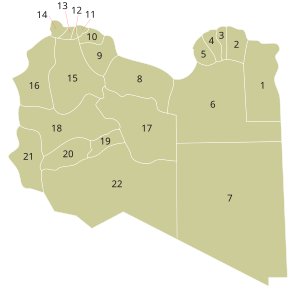

| Arabic | Transliteration | Pop (2006)[72] | Number (on map) |
|---|---|---|---|
| البطنان | Al Butnan | 159,536 | 1 |
| درنة | Darnah | 163,351 | 2 |
| الجبل الاخضر | Al Jabal al Akhdar | 206,180 | 3 |
| المرج | Al Marj | 185,848 | 4 |
| بنغازي | Benghazi | 670,797 | 5 |
| الواحات | Al Wahat | 177,047 | 6 |
| الكفرة | Al Kufrah | 50,104 | 7 |
| سرت | Surt | 141,378 | 8 |
| مرزق | Murzuq | 78,621 | 22 |
| سبها | Sabha | 134,162 | 19 |
| وادي الحياة | Wadi Al Hayaa | 76,858 | 20 |
| مصراتة | Misratah | 550,938 | 9 |
| المرقب | Al Murgub | 432,202 | 10 |
| طرابلس | Tarabulus | 1,065,405 | 11 |
| الجفارة | Al Jfara | 453,198 | 12 |
| الطويبة | Al twebia | 133,198 | Between 12 and 13 |
| الزاوية | Az Zawiyah | 290,993 | 13 |
| النقاط الخمس | An Nuqat al Khams | 287,662 | 14 |
| الجبل الغربي | Al Jabal al Gharbi | 304,159 | 15 |
| نالوت | Nalut | 93,224 | 16 |
| غات | Ghat | 23,518 | 21 |
| الجفرة | Al Jufrah | 52,342 | 17 |
| وادي الشاطئ | Wadi Al Shatii | 78,532 | 18 |
Libyan districts are further subdivided into Basic People's Congresses which act as townships or boroughs.
Main cities
- Tripoli (The capital and largest city).
- Benghazi (The second-largest city).[73]
- Al Bayda (The third largest city).[74]
- Misurata
Geography
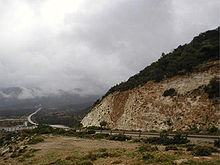
Libya extends over 1,759,540 square kilometres (679,362 sq mi), making it the 17th largest nation in the world by size. Libya is somewhat smaller than Indonesia in land area, and roughly the size of the US state of Alaska. It is bound to the north by the Mediterranean Sea, the west by Tunisia and Algeria, the southwest by Niger, the south by Chad and Sudan and to the east by Egypt. Libya lies between latitudes 19° and 34°N, and longitudes 9° and 26°E.
At 1,770 kilometres (1,100 mi), Libya's coastline is the longest of any African country bordering the Mediterranean.[76][77] The portion of the Mediterranean Sea north of Libya is often called the Libyan Sea. The climate is mostly dry and desertlike in nature. However, the northern regions enjoy a milder Mediterranean climate.

Natural hazards come in the form of hot, dry, dust-laden sirocco (known in Libya as the gibli). This is a southern wind blowing from one to four days in spring and autumn. There are also dust storms and sandstorms. Oases can also be found scattered throughout Libya, the most important of which are Ghadames and Kufra.
Libyan Desert
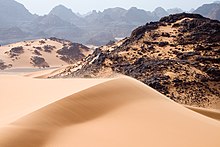

The Libyan Desert, which covers much of Libya, is one of the most arid places on earth.[18] In places, decades may pass without rain, and even in the highlands rainfall seldom happens, once every 5–10 years. At Uweinat, as of 2006 the last recorded rainfall was in September 1998.[78] There is a large depression, the Qattara Depression, just to the south of the northernmost scarp, with Siwa oasis at its western extremity. The depression continues in a shallower form west, to the oases of Jaghbub and Jalo.

Likewise, the temperature in the Libyan desert can be extreme; on September 13, 1922 the town of Al 'Aziziyah, which is located Southwest of Tripoli, recorded an air temperature of 57.8 °C (136.0 °F), generally accepted as the highest recorded naturally occurring air temperature reached on Earth.[79]
There are a few scattered uninhabited small oases, usually linked to the major depressions, where water can be found by digging to a few feet in depth. In the west there is a widely dispersed group of oases in unconnected shallow depressions, the Kufra group, consisting of Tazerbo, Rebianae and Kufra.[78] Aside from the scarps, the general flatness is only interrupted by a series of plateaus and massifs near the centre of the Libyan Desert, around the convergence of the Egyptian-Sudanese-Libyan borders.
Slightly further to the south are the massifs of Arkenu, Uweinat and Kissu. These granite mountains are ancient, having formed long before the sandstones surrounding them. Arkenu and Western Uweinat are ring complexes very similar to those in the Aïr Mountains. Eastern Uweinat (the highest point in the Libyan Desert) is a raised sandstone plateau adjacent to the granite part further west.[78] The plain to the north of Uweinat is dotted with eroded volcanic features. With the discovery of oil in the 1950s also came the discovery of a massive aquifer underneath much of the country. The water in this aquifer pre-dates the last ice ages and the Sahara desert itself.[80] The country is also home to the Arkenu craters, double impact craters found in the desert.
Economy

This section needs to be updated. (February 2011) |
The Libyan economy depends primarily upon revenues from the oil sector, which constitute practically all export earnings and about one-quarter of gross domestic product (GDP). The World Bank defines Libya as an 'Upper Middle Income Economy', along with only seven other African countries.[81] In the early 1980s, Libya was one of the wealthiest countries in the world; its GDP per capita was higher than that of developed countries such as Italy, Singapore, South Korea, Spain and New Zealand.[82]
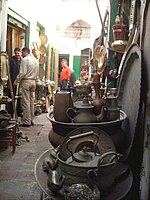
Today, high oil revenues and a small population give Libya one of the highest GDPs per capita in Africa and have allowed the Libyan state to provide an extensive level of social security, particularly in the fields of housing and education.[83] Many problems still beset Libya's economy however; unemployment is the highest in the region at 21%, according to the latest census figures.[84]
Compared to its neighbors, Libya enjoys a low level of both absolute and relative poverty. Libyan officials in the past six years have carried out economic reforms as part of a broader campaign to reintegrate the country into the global capitalist economy.[85] This effort picked up steam after UN sanctions were lifted in September 2003, and as Libya announced in December 2003 that it would abandon programmes to build weapons of mass destruction.[86]
Libya has begun some market-oriented reforms. Initial steps have included applying for membership of the World Trade Organization, reducing subsidies, and announcing plans for privatisation.[87] Authorities have privatised more than 100 government owned companies since 2003 in industries including oil refining, tourism and real estate, of which 29 are 100% foreign owned.[88] The non-oil manufacturing and construction sectors, which account for about 20% of GDP, have expanded from processing mostly agricultural products to include the production of petrochemicals, iron, steel and aluminium.
Climatic conditions and poor soils severely limit agricultural output, and Libya imports about 75% of its food.[85] Water is also a problem, with some 28% of the population not having access to safe drinking water in 2000.[89] The Great Manmade River project is tapping into vast underground aquifers of fresh water discovered during the quest for oil, and is intended to improve the country's agricultural output.
Under the previous Prime Minister, Shukri Ghanem, and current Prime Minister Baghdadi Mahmudi, Libya is undergoing a business boom. Many government-run industries are being privatised. Many international oil companies have returned to the country, including oil giants Shell and ExxonMobil.[90]
Tourism is on the rise, bringing increased demand for hotel accommodation and for capacity at airports such as Tripoli International. A multi-million dollar renovation of Libyan airports has recently[when?] been approved by the government to help meet such demands.[91] At present 130,000 people visit the country annually; the Libyan government hopes to increase this figure to 10,000,000 tourists. However there is little evidence to suggest the current administration is taking active steps to meet this figure. Libya has long been a notoriously difficult country for western tourists to visit due to stringent visa requirements. Since the 2011 protests there has been revived hope that an open society will encourage the return of tourists.[92] Saif al-Islam al-Gaddafi, the second-eldest son of Muammar al-Gaddafi, is involved in a green development project called the Green Mountain Sustainable Development Area, which seeks to bring tourism to Cyrene and to preserve Greek ruins in the area.[93]
Demographics
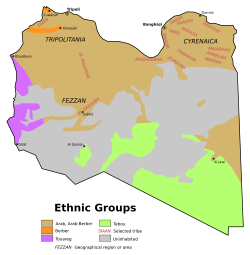
Libya has a small population residing in a large land area. Population density is about 50 persons per km² (80/sq. mi.) in the two northern regions of Tripolitania and Cyrenaica, but falls to less than one person per km² (2.59/sq. mi.) elsewhere. Ninety percent of the people live in less than 10% of the area, primarily along the coast. About 88% of the population is urban, mostly concentrated in the three largest cities, Tripoli , Benghazi and Al Bayda.[94] 50% of the population is estimated to be under age 15.
Native Libyans are primarily Berbers, Arabized Berbers and Turks, ethnic "pure" Arabs (mainly tribal desert Arabs "Bedouins"), and Tuareg. Small Hausa, and Tebu tribal groups in southern Libya are nomadic or seminomadic. Among foreign residents, the largest groups are citizens of other African nations, including North Africans (primarily Egyptians), and Sub-Saharan Africans.[95] Libya is home to a large illegal population which numbers more than one million, mostly Egyptians and Sub-Saharan Africans.[96] Libya has a small Italian minority. Previously, there was a visible presence of Italian settlers, but many left after independence in 1947 and many more left in 1970 after the accession of Muammar al-Gaddafi.[97]
The main language spoken in Libya is Arabic (Libyan dialect) by 80% of the Libyans, and Modern Standard Arabic is also the official language; the Tamazight spoken by 20% (i.e. Berber and Tuareg languages), which do not have official status, are spoken by Libyan Berbers and Tuaregs in the south beside Arabic language.[98] Berber speakers live above all in the Jebel Nafusa region (Tripolitania), the town of Zuwarah on the coast, and the city-oases of Ghadames, Ghat and Awjila. In addition, Tuaregs speak Tamahaq, the only known Northern Tamasheq language, also Toubou language is spoken by Toubou in some pockets in Qatroun village and Koffra city. Italian and English are sometimes spoken in the big cities, although Italian speakers are mainly among the older generation.
Family life is important for Libyan families, the majority of which live in apartment blocks and other independent housing units, with precise modes of housing depending on their income and wealth. Although the Libyan Arabs traditionally lived nomadic lifestyles in tents, they have now settled in various towns and cities.[99] Because of this, their old ways of life are gradually fading out. An unknown small number of Libyans still live in the desert as their families have done for centuries. Most of the population has occupations in industry and services, and a small percentage is in agriculture.
According to the World Refugee Survey 2008, published by the U.S. Committee for Refugees and Immigrants, Libya hosted a population of refugees and asylum seekers numbering approximately 16,000 in 2007. Of this group, approximately 9,000 persons were from the Former Palestine, 3,200 from Sudan, 2,500 from Somalia and 1,100 from Iraq.[100] Libya reportedly deported thousands of illegal entrants in 2007 without giving them the opportunity to apply for asylum. Refugees faced discrimination from Libyan officials when moving in the country and seeking employment.[100]
Education

Libya's population includes 1.7 million students, over 270,000 of whom study at the tertiary level.[101] Basic education in Libya is free for all citizens,[102] and compulsory up until secondary level. The literacy rate is the highest in North Africa; over 82% of the population can read and write.[103]
After Libya's independence in 1951, its first university, the University of Libya, was established in Benghazi.[104] In academic year 1975/76 the number of university students was estimated to be 13,418. As of 2004, this number has increased to more than 200,000, with an extra 70,000 enrolled in the higher technical and vocational sector.[101] The rapid increase in the number of students in the higher education sector has been mirrored by an increase in the number of institutions of higher education.
Since 1975 the number of universities has grown from two to nine and after their introduction in 1980, the number of higher technical and vocational institutes currently stands at 84 (with 12 public universities).[101] Libya's higher education is mostly financed by the public budget.Although a small number of private institutions has been given accreditation lately. In 1998 the budget allocated for education represented 38.2% of the national budget.[104]
The main universities in Libya are:
- Al Fateh University (Tripoli)
- Garyounis University (Benghazi)
- University of Omar Almukhtar (Al Bayda)
The main technology institutions are:
- The Higher Institute of Computer Technology Also known as The College of Computer Technology (Tripoli)
- The Higher Institute of Electronics (Tripoli)
Religion
By far the predominant religion in Libya is Islam with 97% of the population associating with the faith.[105] The vast majority of Libyan Muslims adhere to Sunni Islam, which provides both a spiritual guide for individuals and a keystone for government policy, but a minority (between 5 and 10%) adhere to Ibadism (a branch of Kharijism), above all in the Jebel Nefusa and the town of Zuwarah, west of Tripoli.

Before the 1930s, the Senussi Movement was the primary Islamic movement in Libya. This was a religious revival adapted to desert life. Its zawaaya (lodges) were found in Tripolitania and Fezzan, but Senussi influence was strongest in Cyrenaica. Rescuing the region from unrest and anarchy, the Senussi movement gave the Cyrenaican tribal people a religious attachment and feelings of unity and purpose.[106]
This Islamic movement, which was eventually destroyed by both Italian invasion and later the Gaddafi government,[106] was very conservative and somewhat different from the Islam that exists in Libya today. Gaddafi asserts that he is a devout Muslim, and his government is taking a role in supporting Islamic institutions and in worldwide proselytizing on behalf of Islam.[107] A Libyan form of Sufism is also common in parts of the country.[108]
Other than the overwhelming majority of Sunni Muslims, there are also small foreign communities of Christians. Coptic Orthodox Christianity, which is the Christian Church of Egypt, is the largest and most historical Christian denomination in Libya. There are over 60,000 Egyptian Copts in Libya, as they comprise over 1% of the population.[109][110] There are an estimated 40,000 Roman Catholics in Libya who are served by two Bishops, one in Tripoli (serving the Italian community) and one in Benghazi (serving the Maltese community). There is also a small Anglican community, made up mostly of African immigrant workers in Tripoli; it is part of the Anglican Diocese of Egypt.
Libya was until recent times the home of one of the oldest Jewish communities in the world, dating back to at least 300 BC.[111] In the 1st century, the Jewish historian for the Roman empire, Joseph Flavius, noted that 500,000 Jews lived in Libya.
In 1942, under Fascist Italian orders, the Libyan Muslims instituted several forced labour camps south of Tripoli for the Jews, including Giado (about 3,000 Jews) and Gharyan, Jeren, and Tigrinna. In Giado some 500 Jews died of weakness, hunger, and disease. Summer-Fall of 1942, Jews who were not in the concentration camps were heavily restricted in their economic activity. All Jewish males, 18 to 45 years, were drafted for forced labour. In August 1942, the concentration camp Sidi Azaz interned Jews from the Tripolitania region. In October 350 Jews were deported to the Tobruk area.
Libya was liberated from the Italians on January 23, 1943. The Muslims of Libya responded with a three-day pogrom (November 5–7, 1945) against the Jews. More than 140 Jews were murdered, hundreds more were wounded. This series of pogroms beginning in November 1945 lasted for almost three years, drastically reducing Libya's Jewish population.[112] In 1948, about 38,000 Jews remained in the country. Upon Libya's independence in 1951, most of the Jewish community emigrated. (See History of the Jews in Libya.)
Culture
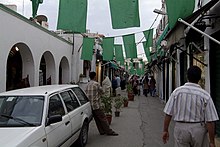

Libya is culturally similar to its neighboring Maghrebian states. Libyans consider themselves very much a part of a wider Arab community. The Libyan state tends to strengthen this feeling by considering Arabic as the only official language, and forbidding the teaching and even the use of the Berber language. Libyan Arabs have a heritage in the traditions of the nomadic Bedouin and associate themselves with a particular Bedouin tribe.
Libya boasts few theatres or art galleries.[113][114] For many years there have been no public theatres, and only a few cinemas showing foreign films. The tradition of folk culture is still alive and well, with troupes performing music and dance at frequent festivals, both in Libya and abroad.
The main output of Libyan television is devoted to showing various styles of traditional Libyan music. Tuareg music and dance are popular in Ghadames and the south. Libyan television programmes are mostly in Arabic with a 30-minute news broadcast each evening in English and French. The government maintains strict control over all media outlets. A new analysis by the Committee to Protect Journalists has found Libya’s media the most tightly controlled in the Arab world.[28] To combat this, the government plans to introduce private media, an initiative intended to update the country's media.[115]
Many Libyans frequent the country's beach and they also visit Libya's archaeological sites—especially Leptis Magna, which is widely considered to be one of the best preserved Roman archaeological sites in the world.[116]
The nation's capital, Tripoli, boasts many museums and archives; these include the Government Library, the Ethnographic Museum, the Archaeological Museum, the National Archives, the Epigraphy Museum and the Islamic Museum. The Jamahiriya Museum, built in consultation with UNESCO, may be the country's most famous.[117]
Contemporary travel
The most common form of public transport between cities is the bus, but many people travel by automobile.[118] There are no railway services in Libya.[118]
Libyan cuisine
This section may contain information not important or relevant to the article's subject. (November 2010) |
Libyan cuisine is generally simple, and is very similar to Sahara cuisine.[119] In many undeveloped areas and small towns, restaurants may be nonexistent, and food stores may be the only source to obtain food products.[119] Some common Libyan foods include couscous, bazeen, which is a type of unsweetened cake, and shurba, which is soup.[119] Libyan restaurants may serve international cuisine, or may serve simpler fare such as lamb, chicken, vegetable stew, potatoes and macaroni.[119] Alcohol consumption is illegal in the entire country.[120]
There are four main ingredients of traditional Libyan food: olives (and olive oil), palm dates, grains and milk.[121] Grains are roasted, ground, sieved and used for making bread, cakes, soups and bazeen. Dates are harvested, dried and can be eaten as they are, made into syrup or slightly fried and eaten with bsisa and milk. After eating, Libyans often drink black tea. This is normally repeated a second time (for the second glass of tea), and in the third round the tea is served with roasted peanuts or roasted almonds (mixed with the tea in the same glass).[121]
See also
Notes
- ^ Department of Economic and Social Affairs
Population Division (2009). "World Population Prospects, Table A.1" (PDF). 2008 revision. United Nations. Retrieved 2009-03-12.
{{cite journal}}: Cite journal requires|journal=(help); line feed character in|author=at position 42 (help) - ^ a b c d "Libya". International Monetary Fund. Retrieved 2010-04-21.
- ^ "Human Development Report 2010" (PDF). United Nations. 2010. Retrieved 5 November 2010.
- ^ U.N. Demographic Yearbook, (2003), "Demographic Yearbook (3) Pop., Rate of Pop. Increase, Surface Area & Density", United Nations Statistics Division. Retrieved July 15, 2006.
- ^ Annual Statistical Bulletin, (2004), "World proven crude oil reserves by country, 1980–2004", O.P.E.C.. Retrieved July 20, 2006.
- ^ World Economic Outlook Database, (April, 2006), "Report for Selected Countries and Subjects", International Monetary Fund. Retrieved July 15, 2006.
- ^ See e. g., the chapter "Les Loouatah" in René Basset, Le dialecte de Syouah, Paris, Leroux, 1890 (pdf text online)(p. 1–14). P. 3: "On voit que les Lebou figurent au premier rang des barbares qui menaçaient l'Egypte du côté de l'ouest ; c'est aussi dans les régions qu'ils occupaient que les auteurs arabes placent les Loouata dont le nom correspond aux Lebou des Egyptiens, aux Loubim de la Bible, aux Levathae (Λευαθαι) de Procope et aux Ilaguaten de Corripus" ("We see that the Lebu are recorded in the first line among the barbarians who threatened Egypt on the western side; in the very regions where they dwelled, the Arab authors place the Lawata, whose name corresponds to the Egyptian Lebu, to the Lubim of the Bible, to the Levathae of Procopius and to the Ilaguaten of Corippus")
- ^ Federal Research Division of the Library of Congress, (1987), "Early History of Libya", U.S. Library of Congress. Retrieved July 11, 2006.
- ^ Herodotus, (c.430 BC), "'The Histories', Book IV.42–43" Fordham University, New York. Retrieved July 18, 2006.
- ^ Federal Research Division of the Library of Congress, (1987), "Tripolitania and the Phoenicians", U.S. Library of Congress. Retrieved July 11, 2006.
- ^ Federal Research Division of the Library of Congress, (1987), "Cyrenaica and the Greeks", U.S. Library of Congress. Retrieved July 11, 2006.
- ^ Heuser, Stephen, (July 24, 2005), "When Romans lived in Libya", The Boston Globe'.' Retrieved July 18, 2006.
- ^ Tadeusz Lewicki, "Une langue romane oubliée de l'Afrique du Nord. Observations d'un arabisant", Rocznik Orient. XVII (1958), pp. 415–480
- ^ Naylor, Phillip Chiviges (2009). North Africa: a history from antiquity to the present. University of Texas Press. pp. 120–121. ISBN 0292719221, 9780292719224.
One of the most famous corsairs was Turghut (Dragut) (?–1565), who was of Greek ancestry and a protégé of Khayr al-Din. ... While pasha, he built up Tripoli and adorned it, making it one of the most impressive cities along the North African littoral.
{{cite book}}: Check|isbn=value: invalid character (help) - ^ Libya, Encyclopædia Britannica
- ^ Ilan Pappé, The Modern Middle East. Routledge, 2005, ISBN 0415214092, p. 26
- ^ Hagos, Tecola W., (November 20, 2004), "Treaty Of Peace With Italy (1947), Evaluation And Conclusion", Ethiopia Tecola Hagos. Retrieved July 18, 2006.
- ^ a b c Salak, Kira. "Rediscovering Libya". National Geographic Adventure.
- ^ Thomas Reed and Danny Stillman, "The Nuclear Express."
- ^ US Department of State's Background Notes, (November 2005) "Libya - History", U.S. Dept. of State. Retrieved July 14, 2006.
- ^ http://blogs.aljazeera.net/middle-east/2011/02/17/live-blog-libya
- ^ http://www.libyafeb17.com/?cat=8
- ^ Cite error: The named reference
bbc updatewas invoked but never defined (see the help page). - ^ Cite error: The named reference
international business timeswas invoked but never defined (see the help page). - ^ Hooper, John; Black, Ian (21 February 2011). "Libya Defectors: Pilots Told to Bomb Protestors Flee to Malta". The Guardian. Guardian News and Media Ltd. Retrieved 21 February 2011.
{{cite web}}: Check|authorlink2=value (help); Check|authorlink=value (help); External link in|authorlink2=and|authorlink= - ^ Carroll, Tom (21 February 2011). "Libya Revolution at Tipping Point as Gaddafi Jets Defect to Malta". Aquapour Global news Online. Retrieved 21 February 2011.
- ^ Federal Research Division of the Library of Congress, (1987), "Government and Politics of Libya", U.S. Library of Congress. Retrieved July 14, 2006.
- ^ a b Special Report 2006, (May 2, 2006), "North Korea Tops CPJ list of '10 Most Censored Countries'", Committee to Protect Journalists. Retrieved July 19, 2006.
- ^ Case Study: Libya, (2001), "Political Culture", Educational Module on Chemical & Biological Weapons Nonproliferation. Retrieved July 14, 2006.
- ^ Hodder, Kathryn, (2000), "Violations of Trade Union Rights", Social Watch Africa. Retrieved July 14, 2006.
- ^ Federal Research Division of the Library of Congress, (1987), "Independent Libya", U.S. Library of Congress. Retrieved July 14, 2006.
- ^ Abadi, Jacob (2000), "Pragmatism and Rhetoric in Libya's Policy Toward Israel", The Journal of Conflict Studies: Volume XX Number 1 Fall 2000, University of New Brunswick. Retrieved July 19, 2006.
- ^ The Columbia Encyclopedia, Sixth Edition, (2001–2005), "Qaddafi, Muammar al-", Bartleby Books. Retrieved July 19, 2006.
- ^ Habib, Henri, (1975), "Politics and Government of Revolutionary Libya, p. 347
- ^ El-Warfally, Mahmoud, (1988), "Imagery and Ideaology in U.S. Policy Toward Libya p.155–174
- ^ St Jhon, Ronlad Bruce, (2002), "Libya and The United States: Two Centuries of Strife" p.135
- ^ El-Warfally, Mahmoud, (1988), "Imagery and Ideaology in U.S. Policy Toward Libya p.173
- ^ Oren, Michael B. "Power, Fantasy and Faith: America in the Middle East from 1776 to the present", p.551
- ^ Boyne, Walter J., (March, 1999), "El Dorado Canyon", Air Force Association Journal, Vol. 82, No. 3. Retrieved July 19, 2006.
- ^ Oren, Michael B. "Power, Fantasy and Faith: America in the Middle East from 1776 to the present", p.557
- ^ (2003), "Libya", Global Policy Forum. Retrieved July 19, 2006.
- ^ Marcus, Jonathan, (May 15, 2006), "Washington's Libyan fairy tale", BBC News. Retrieved July 15, 2006.
- ^ Leverett, Flynt (2004). "Why Libya Gave Up on the Bomb". New York Times. http://www.mtholyoke.edu/acad/intrel/bush/libya.htm. Retrieved on 2006-03-05.
- ^ U.K. Politics, (March 25, 2004), "Blair hails new Libyan relations", BBC news. Retrieved July 15, 2006.
- ^ Information obtained from Libyan Embassy in Washington, D.C. (Feb., 2009)
- ^ Lipton, Eric, April 2008, "Libya Seeks Exemption for Its Debt to Victims" New York Times.
- ^ Information obtaned from Libyan Embassy (Feb., 2009)
- ^ "Libya secures UN council posting". BBC News. October 16, 2007. Retrieved 2007-10-17.
- ^ http://news.bbc.co.uk/2/hi/africa/country_profiles/819291.stm
- ^ "Canadians not welcome in Libya: Gadhafi". Toronto Star News Network. October 26, 2009. Retrieved 2009-10-25.
- ^ "Libya Urged To Free Swiss Nationals". International Relations and Security Network. Retrieved 2009-09-04.
- ^ a b "[[:Template:Italian]] Ratifica ed esecuzione del Trattato di amicizia, partenariato e cooperazione tra la Repubblica italiana e la Grande Giamahiria araba libica popolare socialista, fatto a Bengasi il 30 agosto 2008". Parliament of Italy. 2009-02-06. Retrieved 2009-06-10.
{{cite web}}: URL–wikilink conflict (help) - ^ a b c d e "Gaddafi to Rome for historic visit". ANSA. 2009-06-10. Retrieved 2009-06-10. [dead link]
- ^ "Berlusconi in Benghazi, Unwelcome by Son of Omar Al-Mukhtar". The Tripoli Post. 2008-08-30. Retrieved 2009-06-10.
- ^ "Italia-Libia, firmato l'accordo". La Repubblica. 2008-08-30. Retrieved 2009-06-10.
- ^ "Libya agrees pact with Italy to boost investment". Alarab Online. 2009-03-02. Retrieved 2009-06-10.
- ^ "Gheddafi a Roma, tra le polemiche". Democratic Party. 2009-06-10. Retrieved 2009-06-10.
- ^ "Gheddafi protetto dalle Amazzoni". La Stampa.
- ^ "[[:Template:Italian]] Gheddafi a Roma: Radicali in piazza per protestare contro il dittatore". Iris Press. 2009-06-10. Retrieved 2009-06-10.
{{cite news}}: URL–wikilink conflict (help) [dead link] - ^ "United States, Congress US Deptartment Of State, Bureau of Democracy, Human Rights, and Labor. 2007 Country Reports on Human Rights Practices. November 23, 2008". State.gov. 2008-03-11. Retrieved 2010-05-02.
- ^ "Freedom in the World 2006" (PDF). Freedom House. 2005-12-16. Retrieved 2006-07-27.
See also Freedom in the World 2006, List of indices of freedom - ^ Pan, Chia-Lin (1949) "The Population of Libya" Population Studies, 3(1): pp. 100–125, p. 104
- ^ Zeidan, Shawky S. (1988) "Chapter 4 - Government and Politics: Internal Politics: Subnational Government and Administration" A Country Study: Libya from Federal Research Division, Library of Congress. Retrieved 14 February 2009.
- ^ "Map of Libya 1976" WHKMLA: Historical Atlas, Libya
- ^ Nyrop, Richard F. (1973) "Table 10: Governorates and Districts of Libya 1972" "Area Handbook for Libya" (2nd ed.) United States Department of the Army, Washington, DC, p. 159 OCLC 713653
- ^ a b Zeidan, Shawky S. (1988) "Chapter 4 - Government and Politics: Internal Politics: Subnational Government and Administration: The Cultural Revolution and People's Committees" A Country Study: Libya from Federal Research Division, Library of Congress
- ^ See map of 25 baladiyat in Districts of Libya
- ^ 1993 CIA Political Map of Libya from Perry-Castañeda Library, University of Texas at Austin. Retrieved 14 February 2009.
- ^ Lahmeyer, Jan, (November 26, 2004), "Historical demographical data of the administrative division", University Library, Universiteit Utrecht, from WebArchive, dated 27 June 2003
- ^ "Municipalities of Libya". Statoids.com. Retrieved 2010-05-02.
- ^ Jamahiriya News Agency, (July 19, 2004), "Masses of the Basic People's Congresses select their Secretariats and People's Committees" Mathaba News. Retrieved July 19, 2006.
- ^ Libyan General Information Authority. Retrieved 22 July 2009.
- ^ UPI News
- ^ Independent Media Center Australia
- ^ Federal Research Division of the Library of Congress, (1987), "Climate & Hydrology of Libya", U.S. Library of Congress. Retrieved July 15, 2006.
- ^ (2005), "Demographics of Libya", Education Libya. Retrieved June 29, 2006.
- ^ (July 20, 2006), "Field Listings - Coastlines", CIA World Factbook. Retrieved July 23, 2006.
- ^ a b c Zboray, András, "Flora and Fauna of the Libyan Desert", Fliegel Jezerniczky Expeditions. Retrieved July 14, 2006.
- ^ Hottest Place, "El Azizia Libya, 'How Hot is Hot?'", Extreme Science. Retrieved July 14, 2006.
- ^ ""Fossil Water" in Libya", NASA. Retrieved March 24, 2007.
- ^ World Bank, Upper Middle Income Economies, World Bank. Retrieved November 25, 2009.
- ^ Philips' Modern School Atlas, 1987, 1983 GNP per capita figures are quoted in a list.
- ^ United Nations Economic & Social Council, (February 16, 1996), "Libyan Arab Jamahiriya Report", Office of the United Nations High Commissioner for Human Rights. Retrieved July 14, 2006.
- ^ (March 2, 2009), Libya's Jobless Rate at 20.7 Percent, Reuters Africa. Retrieved March 2, 2009.
- ^ a b The World Factbook, (2006), "Economy - Libya", CIA World Factbook. Retrieved July 14, 2006.
- ^ W.M.D., (2003), "Libya Special Weapons News", Global Security Report. Retrieved July 14, 2006.
- ^ Reuters, (July 28, 2004), "Libya to start WTO membership talks", Trade Law Centre for Southern Africa. Retrieved July 16, 2006.
- ^ (July 24, 2009) Libya expects nearly $2 bln in new FDI Reuters Africa. Retrieved July 27, 2009.
- ^ (2001), "Safe Drinking Water", WHO/UNIADF Joint Monitoring Programme. Retrieved October 8, 2006.
- ^ Volume: 23, No. 27, (2006), "Shell returns to Libya with gas exploration pact", Oil & Gas Worldwide News. Retrieved July 14, 2006.
- ^ Jawad, Rana, (May 31, 2006), "Libyan aviation ready for take-off", BBC News. Retrieved July 22, 2006.
- ^ Bangs, Richard. "Libya sees thriving tourism industry ahead". MSNBC. Retrieved 2007-10-10.
{{cite news}}: Unknown parameter|coauthors=ignored (|author=suggested) (help) - ^ A Green Resort Is Planned to Preserve Ruins and Coastal Waters, The New York Times.
- ^ Aljazeera.net - Al Jazeera News
- ^ African immigrants flee Libya. AllBusiness.com. November 1, 2000.
- ^ Marching orders for migrants in Libya?. BBC News. January 23, 2008.
- ^ Libya – Italian colonization. Encyclopædia Britannica.
- ^ Anderson, Lisa, (2006), "'Libya', III. People, B. Religion & Language", MSN Encarta, Accessed July 17, 2006. Archived 2009-10-31.
- ^ Al-Hawaat, Dr. Ali, (1994), "The Family and the work of women, A study in the Libyan Society" National Center for Research and Scientific Studies of Libya. Retrieved July 19, 2006.
- ^ a b "World Refugee Survey 2008". U.S. Committee for Refugees and Immigrants. 2008-06-19.
- ^ a b c Clark, Nick, (July 2004), "Education in Libya", World Education News and Reviews, Volume 17, Issue 4. Retrieved July 22, 2006.
- ^ Federal Research Division of the Library of Congress, (1987), "Education of Libya", U.S. Library of Congress. Retrieved July 22, 2006.
- ^ "About Libya". Office of the Middle East Partnership Initiative. United States Department of State. 2003. Retrieved 2007-10-10.
- ^ a b El-Hawat, Ali, (2000), "Country Higher Education Profiles - Libya", International Network for Higher Education in Africa". Retrieved July 22, 2006.
- ^ Religious adherents by location, "'42,000 religious geography and religion statistics', Libya" Adherents.com. Retrieved July 15, 2006.
- ^ a b Federal Research Division of the Library of Congress, (1989), "The Sanusis", U.S. Library of Congress. Retrieved July 22, 2006.
- ^ Federal Research Division of the Library of Congress, (1989), "Islam in Revolutionary Libya", US Library of Congress. Retrieved July 19, 2006.
- ^ Libya - Religion, (July 8, 2006), "Sufi Movement to be involved in Libya" Arabic News. Retrieved July 19, 2006.
- ^ Tore Kjeilen. "Looklex Encyclopedia: 1% of Libya's population (6.1 million) adhere to the Coptic Orthodox faith". I-cias.com. Retrieved 2010-05-02.
- ^ "International Religious Freedom Report: Libya" Jewish Virtual Library. Retrieved July 19, 2006.
- ^ The World Jewish Congress, "History of the Jewish Community in Libya", University of California at Berkeley. Retrieved July 16, 2006.
- ^ Harris, David A. (2001), "In the Trenches: Selected Speeches and Writings of an American Jewish Activist", 1979–1999, pp. 149–150
- ^ News and Trends: Africa, (September 17, 1999), "Libya looking at economic diversification" Alexander's Gas & Oil Connections. Retrieved July 19, 2006.
- ^ About Libya, "Libya Today", Discover Libya Travel. Retrieved July 14, 2006.
- ^ (January 30, 2006), "Libya to allow independent media", Middle East Times. Retrieved July 21, 2006.
- ^ Donkin, Mike, (July 23, 2005), "Libya's tourist treasures", BBC News. Retrieved July 19, 2006.
- ^ Bouchenaki, Mounir, (1989), "The Libyan Arab Jamahiriya Museum: a first in the Arab world", UNESCO, Museum Architecture: beyond the <<temple>> and ... beyond. Retrieved July 19, 2006.
- ^ a b Looklex.com. Libya - Getting there. Retrieved on August 26, 2008.
- ^ a b c d Looklex.com. "Libya - Eat and Sleep" Retrieved on August 26, 2008.
- ^ Looklex.com. "Libya Facts" Retrieved on August 26, 2008.
- ^ a b Temehu.com. "Libyan Food"
References
Libya Brady Adrienne, Melrose Books Libya -Kiss The Hand You Cannot Sever. ISBN 1906050600 Hardcover: 267 pages; Publisher: Melrose Books; First Edition edition (1 May 2008); Language English; ISBN 978-1-906050-60-3
- Libya, Anthony Ham, Lonely Planet Publications, 2002, ISBN 0-86442-699-2
- Libya Handbook, Jamez Azema, Footprint Handbooks, 2001, ISBN 1-900949-77-6
- Harris, David A. (2001). In the Trenches: Selected Speeches and Writings of an American Jewish Activist, 1979–1999. KTAV Publishing House, Inc. ISBN 0-88125-693-5
- Wright, Muhannad B. Nations of the Modern World: Libya, Ernest Benn Ltd, 1969
![]() This article incorporates public domain material from The World Factbook. CIA.
This article incorporates public domain material from The World Factbook. CIA.
![]() This article incorporates public domain material from U.S. Bilateral Relations Fact Sheets. United States Department of State.
This article incorporates public domain material from U.S. Bilateral Relations Fact Sheets. United States Department of State.
External links
- General People's Committee (The Cabinet)
- "Libya". The World Factbook (2025 ed.). Central Intelligence Agency.
- Libya from UCB Libraries GovPubs
- Libya Real Time Video Stream at Frequency
- Template:Dmoz
 Wikimedia Atlas of Libya
Wikimedia Atlas of Libya- Template:Wikitravel
27°24′N 17°36′E / 27.4°N 17.6°E
Template:Link GA Template:Link GA Template:Link FA Template:Link FA ak:Libya
- Current events from February 2011
- Ill-formatted IPAc-en transclusions
- Libya
- African countries
- African Union member states
- Arab League member states
- Arabic-speaking countries
- Countries of the Mediterranean Sea
- Military dictatorship
- Socialist states
- OPEC member states
- Organisation of the Islamic Conference members
- Political engineering by coup
- States and territories established in 1951



